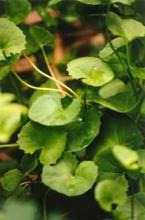
Gotu kola
Centella asiatica
This diminutive ground cover is a member of the Parsley family, the Apiaceae. It originally came to us from the Indian subcontinent, where it grows widespread in sunny, wet places like drainage and irrigation ditches. Here, it can be grown as an annual or, in a heated greenhouse or at warmer latitudes, as a perennial. It is harvested for its leaf, which resembles a little green seashell with scalloped edges.
Elemental associations: Air
Phytochemistry: Organic acids, phytosterols, flavonoids, volatile oil, tannin
Actions: Vascular tonic, collagen production stimulant, mild anti-inflammatory and relaxant, antiulcer, GABA-minetic
Specific systems: Circulatory, connective tissue, digestive, nervous
This plant should be used fresh, either as the fresh leaf of as a fresh-plant extract as its organic acids, partly responsible for its effects, can degrade significantly during drying. Beware also of non-organic sources, as the harvesting environment may be questionable and quite polluted.
Gotu Kola is chiefly a remedy of the circulation, improving venous and capillary integrity and thus helping to contain chronic inflammation and aiding in circulatory imbalances, such as cold hands and feet or decreased mental function due to deficient circulation. Additionally, it has a mild sedative and anti-anxiety effect that can also help improve focus and mental performance.
It also speeds the recovery of soft-tissue injuries where collagen production is required (tendonitis, strains and sprains) while helping to contain inflammation.
Finally, it seems to have a direct ulcer-healing effect, though more research is required for this particular use.
Indications: Circulatory deficiency, soft tissue injuries (esp. if chronic), ulcers
Contraindications: Avoid during pregnancy and lactation, and use caution combining it with other sedating / anti-anxiety / antidepressant herbs or drugs.
Preparation/Dosage: Best eaten fresh, 1-2 leaves per day as a tonic and 3-5 leaves per day for injuries. Fresh tincture, prepared at 40% and 1:5, can be taken in doses of 30-60 drops (1-2ml) 1-3 times a day depending on the condition. Except for the conditions listed under contraindications, it is a generally safe herb to use and overdoses have not been reported.
